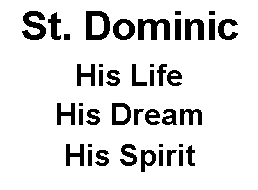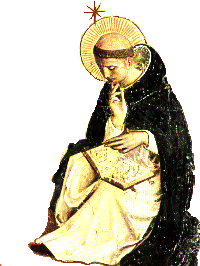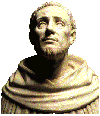

From the ACTS OF THE 1990 PROVINCIAL CHAPTER
- Part 1: The Apostolic Life, Prologue, #26 -Our Identity as Preachers.
- If we are to have any distinctive identity, either as individuals, as a Province, or as an Order, in today's world and today's Church; if we are to be of any distinctive service to our brothers and sisters; if we are to be that which each of us, in our hearts wants to be, we must reclaim the vision of our Founder who referred to himself and his small group of followers as "The Preaching of Jesus Christ and "The Holy Preaching." We must, in short, see ourselves, collectively and individually, as "The Holy Preaching." This vision of ourselves as "The Holy Preaching" is a vision that needs rebirth among us today.
-

The Albigensians
The founder of the Friars Preachers was born of a Castilian family, and his early years were uneventful. When he was about twenty-six he became one of the canons regular who formed the cathedral chapter at Osma; in 1206 the turning-point of his life came, when his bishop, Diego, became unofficial leader of a papal mission to the heretical Albigenses, who were firmly established in Languedoc. The bishop chose Dominic as his companion; they lived simply and in poverty, and undertook discussions with their opponents for which they prepared very carefully. These methods contrasted with the formality and display of the official missioners, and a house of nuns founded at Prouille became the center of the new preachers. The death of Bishop Diego at the end of 1207 coincided with the murder of the papal legate Peter de Castelnau by the Albigenses, and Pope Innocent III ordered a military campaign against their leader, Count Raymund of Toulouse. There followed five years of bloody civil war, massacre, and savagery, during which Dominic and his few followers persevered in their mission of converting the Albigenses by persuasion addressed to the heart and mind.
The Early Preaching
In 1215 Dominic was able to establish his headquarters in Toulouse, and the idea of an order of preachers began to take shape: a body of highly trained priests on a monastic basis, bound by vows with emphasis on poverty, but devoted to the active work of preaching and teaching anywhere and everywhere. The enterprise was formally approved at Rome in 1216, and in the following year the founder sent eleven of this brothers, over half the then total, to the University of Paris and to Spain. He himself established friaries at Bologna and elsewhere in Italy, and travelled tirelessly to superintend the nascent order, preaching as he went. St. Dominic always gave importance to the help of women in his work; one of his last undertakings was to install nuns at San Sisto in Rome; another was to send thirteen of his friars to Oxford.
The Saint
|
|
All the evidence goes to show that St. Dominic was a man of remarkable attractiveness of character and broadness of vision; he had the deepest compassion for every sort of human suffering; he saw the need to use all the resources of human learning in the service of Christ; his constant reading was St. Matthew's gospel, St. Paul's letters and the Conferences of St. John Cassian. The order that he founded was a formative factor in the religious and intellectual life of later medieval Europe; its diffusion is now world-wide. This saint was the subject of the song 'Domininque' that was so popular in 1963-4; his emblems are a star and a dog with a torch in its mouth. From Donald Attwatter, The Penguin Dictionary of Saints, Penguin Books, 1963. |
| Index | Home | O P Sites | Search | |
